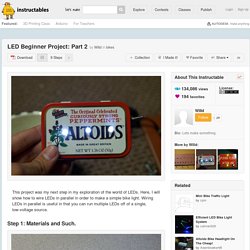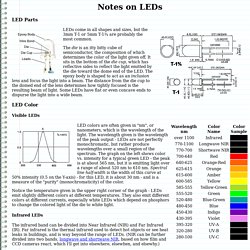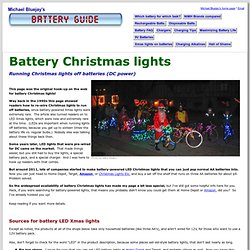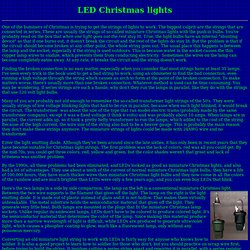

LED Beginner Project: Part 2. This project was my next step in my exploration of the world of LEDs.

Here, I will show how to wire LEDs in parallel in order to make a simple bike light. Wiring LEDs in parallel is useful in that you can run multiple LEDs off of a single, low-voltage source. Step 1: Materials and Such. I've always been looking for a reason to use an Altoids tin as a project box, and this project seemed to be it. - Altoids tin - 2 AAA battery holder from Radioshack In my previous Instructable, I explained how LEDs need to have resistors wired in series with them to keep them from blowing out. Step 2: Why Parallel Is Awesome. Wiring LEDs in parallel opens up new ways of using them.
Notes on LEDs. LED Parts LEDs come in all shapes and sizes, but the 3mm T-1 or 5mm T-1¾ are probably the most common.

The die is an itty bitty cube of semiconductor, the composition of which determines the color of the light given off. It sits in the bottom of the die cup, which has reflective sides to reflect the light emitted by the die toward the dome end of the LED. The epoxy body is shaped to act as an inclusion lens and focus the light into a beam. LED Chaser. Battery Christmas Lights: How to convert Xmas lights to run on batteries/DC (regular or LED) Running Christmas lights off batteries (DC power) This page was the original hook-up on the web for battery Christmas lights!

Way back in the 1990s this page showed readers how to re-wire Christmas lights to run off batteries, since battery-powered Xmas lights were extremely rare. The article also turned readers on to LED Xmas lights, which were new and extremely rare at the time. (LEDs are important when running lights off batteries, because you get up to sixteen times the battery life vs. regular bulbs.) Nobody else was talking about these things back then. Some years later, LED lights that were pre-wired for DC came on the market. But around 2011, lots of companies started to make battery-powered LED Christmas lights that you can just pop normal AA batteries into.
So the widespread availability of battery Christmas lights has made my page a bit less special, but I've still got some helpful info here for you. Keep reading if you want more details. LED Christmas lights. One of the bummers of Christmas is trying to get the strings of lights to work.

The biggest culprit are the strings that are connected in series. These are usually the strings of so-called miniature Christmas lights with the push-in bulbs. You've probably read on the box that when one light goes out the rest stay lit. True, the light bulbs have an internal "shunting device" so that if one burns out, it doesn't break the circuit and the rest of the lights do stay lit.
But the problem is that if the circuit should become broken at any other point, the whole string goes out. Finding the broken connection is no easy matter, especially when you consider that most strings have at least 35 lamps. Many of you are probably not old enough to remember the so-called transformer light strings of the 50's. Enter the light emitting diode. By the 1990s, all these problems had been eliminated, and LEDs looked as good as miniature Christmas lights, and also had a lot of advantages.
Neon light strings. LED series parallel array wizard. Don's LED Main Page. Most recent update or addition in anything below of mine 2/16/2014, with the latest noted update on links offsite from here 4/6/2014.

Efficient and bright LEDs! Efficiency of some good ones and some runner-ups in lumens per watt, millicandela and beam angle ratings for some of these, where to get most of these. Also links. (updated 2/16/2014) The above file as of 5/11/2008 before removal of most notes on items noted in 2002 or before then. Why LEDs outperform incandescents more in specialty applications than in general lighting. Low Current LEDs - Use just a few milliamps or easily even .22-2 mA for LED indicator lamps! My LED FAQ! "LEDs 101" or "LEDs For Dummies" - how to make them work, why to use a dropping resistor instead of a 2.4 or whatever volt regulator. The truth of pulsing LEDs to make them appear brighter. (My "odd LED" page has been removed 2/9/2009.) My Yellow SiC LED Page - I managed to get my hands on one of those rare LEDs!
Alan Parekh's Electronic Projects - LED Resistor Calculator. LED calculator for single LEDs.